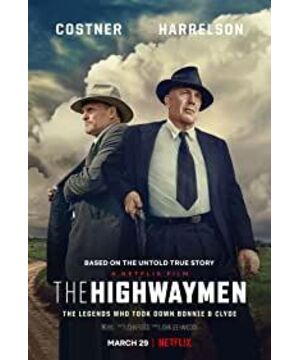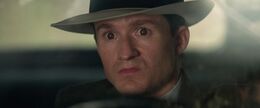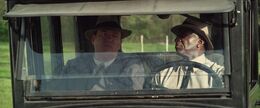"Bonnie and Clyde" is undoubtedly a Hollywood classic. Whether it’s the movie itself, or the actors Warren Beatty and Fei Dunaway, or the archetypal incident, it’s all the rage in contemporary America. In that movie, the idol road killer CP group all produced a taste of poetry and distance, exuding the "beat" temperament that was popular in the 1960s when the movie was made into a movie - this pair of male and female thieves , just like Jack Kerouac's literary characters, with melancholy about the times and confusion about the future, embarked on a fateful journey of self-destruction. The movie, which was in line with the American social ideology at the time, further polished the idol halo of Bonnie and Clyde at the time, making them a kind of ICON.
In this "Robbers", the director switched his perspective from the robber to the hunter. Not only that, the director also tried to dig the Bonnie and Clyde incident from an objective point of view—the deep-seated content reflected by this social incident. Compared with "Bonnie and Clyde", and the various "road robbers" works made by Hollywood until now (such as "Public Enemy" starring Johnny Depp, and "Born to Kill" in contemporary time and space ), abandoning the creative idea of idolizing robbers, which is not very common.
The reversal of the image tendencies of the thief's side is already established at the beginning of the film. Bonnie and Clyde's car drove across the highway and stopped in the middle of a wilderness. Bonnie got out of the car and stood in the woods with his back to the camera, and everything was silent - a standard "poetry". With the distance" style robber film transport mirror. But, in fact, in the first shot, this superficial "poetry and distance" has been broken - the car as the beginning of it all, a piece of oil raised by the road under the scorching sun Covered by the quality, the outline becomes blurred under the lens. With this picture, the director has hinted at the film's denial of the traditional definition of male and female thieves. And further, in the subsequent progress of the plot, the subversion of the images of Bonnie and Clyde was further established-the two rescued their accomplices to escape from prison, and the accomplices killed the guards who graciously chatted with themselves MLB personnel (highlighted by the overhead shot of the man being shot), and Bonnie and Clyde even left a companion as they fled—a nod to the traditional image of the "rogue against the age". Completely reversed. In this opening scene, the director accurately and concisely hints and then expresses, which completes the breaking of the traditional image of male and female thieves and establishes the tone of the film, which can be called extremely beautiful.
Then, the director gradually expanded what he wanted to explore: the essential phenomenon reflected behind this social event. First, in the second scene immediately after the opening, a female U.S. government official is discussing countermeasures with her subordinates, and she rejects the proposal to reactivate the old-time artifact of the Mounted Police ("This is the America of the thirties"). , and continue to insist on using the police system under its own "institutionalization of this era" to resolve the incident. And the result of doing this was also revealed in the follow-up films: countless police officers died under Bonnie's guns, and the CP group was always at large, dancing recklessly on the contemporary police system. The reason for this is reflected in the case of a young police officer-he was preemptively shot by Bonnie and Clyde after warning him in accordance with the regulations, and the bullets did not even have time to load. This shows that Bonnie and Clyde are an existence that does not obey contemporary rules at all. They are things that cannot be controlled by the system of the new age. When killing the young policeman, Bonnie turned over the policeman's body to let him He watched his own being killed, reflecting the wildness and cruelty that Bonnie has separated from contemporary social elements; and the "overhead shot of the killed police officer" used again at the end of the scene also forms a connection with the above-mentioned overhead shot, once again The twist in the image of Bonnie and Clyde is emphasized. Therefore, in the director's conception, Bonnie and Clyde are separated from the primitive existence of contemporary civilized society. Contemporary rules, concepts and even technology are completely unable to subdue them - the police are equipped with on-board liaisons. (And show it to Woody Harrelson—a sign that the Mounties are behind the times), but it doesn't help with arrests. For this layer, the director used the car used by the protagonist of the thief and the mounted police to reach a hint: in the first scene, the director deliberately used a close-up to emphasize the car logo in front of the thief's car, and in the movie, the director also repeatedly The same car logo of the protagonist was photographed with a close-up---to establish the identity of the protagonist and the thief, to illustrate that the thief and the mounted police belong to the old era and do not belong to the content of the current era.
During the pursuit of the two mounted police protagonists, what they felt was the acceptance of Bonnie and Clyde in contemporary society, as well as the status quo of American society in the 1930s. constitutes the main content of the film. First of all, Costner saw the support for the thief written on the water pump, and the female car owner next to him was wearing the same outfit as Bonnie; and after the two-man mounted police team was established, the two also first in Clay De's hometown and the various regions he has traveled through have felt the support of the ordinary American people who are chasing after the thief like a music superstar and wearing the same style of clothing as if they are chasing the trend. In addition, during the pursuit, the director also repeatedly focused on the American nationals who were impoverished and lost their homes due to the economic crisis. Obviously, the director deliberately guides the audience to make them understand the social reality reflected by the events of Bonnie and Clyde: due to the economic crisis in the 1930s, the American people fell into extreme embarrassment in material life, thus losing hope for the future, and in the The mentality of the Chinese people under despair and anger towards the upper classes has degenerated from the moral outlook of contemporary civilization, and has turned to the conceptual identification and psychological pursuit of lawbreakers and murderers - just as people in ancient times sought out Robin Hood.
From another point of view, the film also gives a certain degree of display to the American government, the cause of this social phenomenon. In the passage where the female official appeared, she immediately put on a smile to respond to social situations after pressuring her subordinates and expressing her disdain for the protagonist of the mounted police, showing the social and hypocritical state of contemporary politicians; during the pursuit of the protagonist In China, the government police who follow along with them also have the power to eavesdrop on private telephones - the "innovation" led by Hoover, the destruction of personal privacy, the 1930s version of the prism door. The U.S. government shown in the film is undoubtedly an existence that violates national rights, is hypocritical and superficial, and leads the people to the uncivilized values of Bonnie and Clyde. And if we explore the causes of the US economic crisis in the 1930s, we can also find the role of the US government in it: without the massive and unrestrained quantitative easing carried out by the government in pursuit of economic growth, inflation would not have lost the possibility of being suppressed.
And the protagonist duo's feelings about the current state of American society at the time also have a gradually changing process curve. In the beginning, Costner had lived a "contemporary life" away from hunting and killing, but the brutal incidents of "reckless murder by male and female thieves" took him away from such a stable job and a rich life. The contemporary civilized life has returned to the work of the old era of living in the wind and sleeping in the rough and fighting for life. From this point, the director hints, intentionally or unintentionally, that Costner wants to reverse the "return to desolation" in the ideological trend of American society, and try his best to change this era in order to kill the source of everything - Bonnie and Clyde's Way. Afterwards, the protagonist duo also formed frequent interactions with the society at that time: in some moments, the two seemed to have changed something - beat the gas station man who supported the thief and asked him to give information, teach him a lesson in the bar Clyde is the king's rogue; however, on the whole, the social state they feel and the feedback they receive from the people make them more and more negative-----the poor people everywhere, the state Wherever he went, he was sought after by idols, and when the two pursued them, they were even blocked by the people in the street.
For the two protagonists, what they feel is the irreversibility of the increasingly strong social regression, which makes them more pessimistic about the prospect of arrest under contemporary rules, and their own behaviors gradually tend to be "primitive": In the beginning, Costner tried his best to abide by the authority delineated by the document, but the progress was slow, which forced him to ignore it gradually, from forcibly breaking the road blocked by the police, to handling cases outside the scope of authority, and further. To the last "shoot to death and then raise your hand" ignoring the rule. That is to say, the change curve of the pursuit and the change curve of the protagonist's compliance with contemporary rules form an inverse relationship - the more the protagonist's behavior violates the contemporary, the more the pursuit of Bonnie and Clyde will be. more effective. This actually coincides with the above-mentioned "identity of the protagonist and the thief": both are more retrogressive beings than the current era, and only after the protagonist completely abandons the contemporary rules can he defeat the thief. In the part of killing the robber, the director first arranged a dialogue between Costner and Clyde's father, emphasizing that "the difference between me and Clyde is only an accidental influence in Costner's thought, my impulse killed the prisoner, Clyde Virtue’s impulse violates the law” to emphasize Costner’s negative view of human nature being distorted by the times and purely by accident; then, he shared the old-time experience of “killing people first and then going through the process when I was young”, making everyone like this Do, go and kill the thief according to the style of the thief, and in the subsequent arrest, the director also used several close-ups of "Bonnie didn't have time to pick up the gun", which made Bonnie correspond to the young policeman who didn't have time to put the bullet in-- -Bonnie who didn't follow contemporary rules killed the cops, and Costner, who also didn't follow the rules, killed Bonnie.
However, for the two protagonists, this is obviously a pessimistic result: they try to kill the reverse current of the times by hunting them down, but in the end they can only complete the work by entering the reverse current themselves, to admit the retrogression of social civilization . In the ending part, the two protagonists stand in front of the window, and the people who frantically follow the robber's body are reflected in the window. This is undoubtedly a very pessimistic composition. The protagonist kills the iconic leading existence of the social countercurrent, but it cannot change the trend of social thought---because the root of all this is not the male and female thieves, the thieves are only the national trend of thought The sustenance, there will be others without Bonnie and Clyde, the real root lies in the actions of the authorities, which cannot be changed by the protagonist. Under such a scene, the director also made it very clear that the expression of the film falls on the "criticism of the official authorities that caused the great social depression".
What's more interesting is that in the movie, the director arranged three rains. The first rain happened at the beginning, and the female officials expressed that it was extremely difficult to use the police system to complete the arrest. The second rain occurred in the middle section. The two protagonists followed the authority given to them by the document to pursue the murderer, but found that their strength was limited; the third rain occurred before the climax. of torture. It can be seen that these three rains are auxiliary hints of the gloom of the social state at that time - the first one shows the powerlessness of the contemporary system under the countercurrent of the times, and the latter two shows the protagonist's reaction to the fact that the times are against the current. Two layers of intuitive feeling.
It can be seen that in the film, the director focused on "the social status quo at that time". It can be said that "time" is the real focus of this film. Compared with "Bonnie and Clyde", such an angle of analyzing the social status quo behind the event is indeed a valuable but still scarce starting point.
However, in the works, there is a very big problem: the display and analysis of the social status quo is not simple and superficial. What the director gave is the whole society's pursuit of male and female thieves, as well as some help for the thieves. However, why did people have a countercurrent in values, what was the real life dilemma of the people at that time, and what was the role of the authorities in it (the government officials and police were rarely present, and there was a lack of detailed behavior explanations, It seems to be more like simply causing trouble to the protagonist), all of which are white blanks. This directly leads to the flatness and monotony of the main content of the film, and seriously affects the realization of the original intention of "event-based analysis of society".
The result of this huge flaw is that the look and feel of the finished film is more like a story of an old protagonist who is old and strong, an American version of "Long San and His Seven Accomplices", "Old Pao Er" - an aging protagonist Life has been calm, but with great determination, facing the well-equipped police competitors and the high-ranking officials who are despised in every possible way, facing the order and rules of the new era, he carries out his own stubborn struggle. Compared with the original intention of creation that is more social, the story of an old cannon is obviously less valuable for creation.
View more about The Highwaymen reviews











